😶AP BIO Chapter 23 - Broad Patterns of Evolution
Overview
23.1 The fossil record documents life’s history
23.2 The rise and fall of groups of organisms reflect differences in speciation and extinction rates
23.3 Major changes in body form can result from changes in the sequences and regulation of developmental genes
23.4 Evolution is not goal oriented
BIG IDEAS: Speciation and extinction have occurred throughout Earth’s history (Big Idea 1), with changes in the conditions on Earth leading to divergence in homeostatic and developmental mechanisms (Big Idea 2)
Fossil of Dorudon atrox, an ancient whale
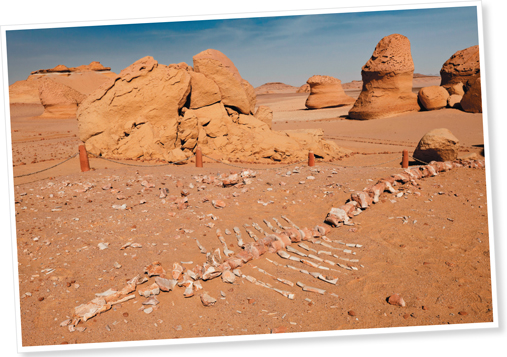
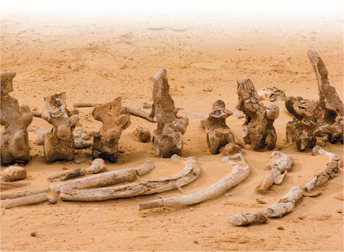
What do the whale’s bones in the desert show?
It shows early steps in the transition from life on land to life in the sea
<<Macroevolution:<<
Evolutionary change above the species level
==23.1 - The fossil record documents life’s history==
The fossil record, based largely on fossils found in sedimentary rocks, documents the rise and fall of different groups of organisms over time. Sedimentary strata reveal the relative ages of fossils. The absolute ages of fossils can be estimated by radiometric dating and other methods
The study of fossils has helped geologists establish a geologic record of Earth’s history
The fossil record shows how new groups of organisms can arise via the gradual modification of preexisting organisms
Documenting the history of life - These fossils illustrate representative organisms from different points in time. Although prokaryotes and unicellular eukaryotes are shown only at the base of the diagram, these organisms continue to thrive today. In fact, most organisms on Earth are unicellular
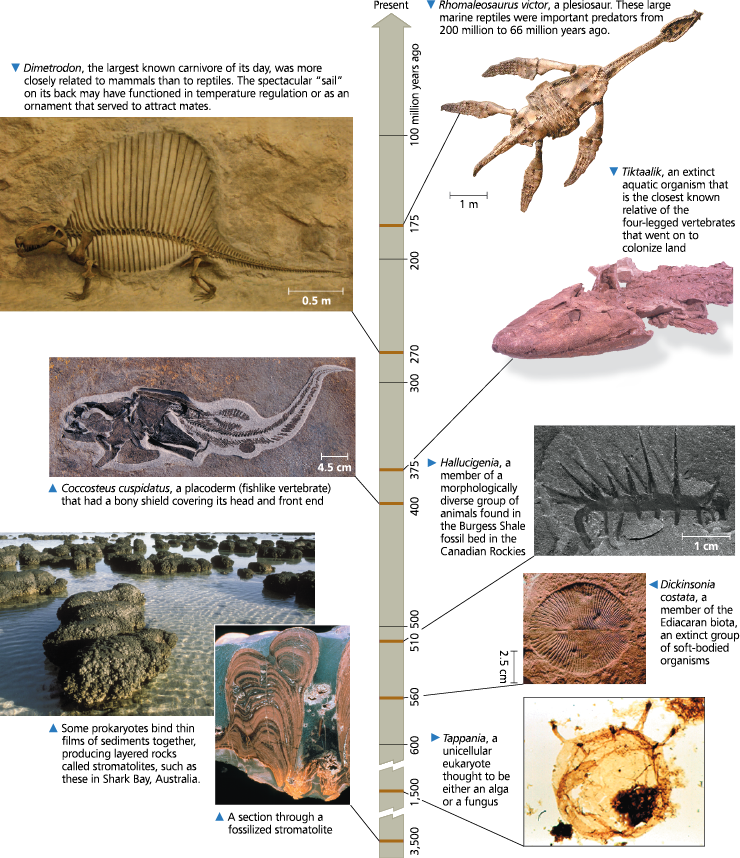
<<Strata:<<
A rock layer formed when new layers of sediment cover older ones and compress them
<<Radiometric Dating:<<
A method for determining the absolute age of rocks and fossils, based on the half-life of radioactive isotopes
<<Half-Life:<<
The amount of time it takes for 50% of a sample of a radioactive isotope to decay
Radiometric dating - In this diagram, each unit of time represents one half-life of a radioactive isotope
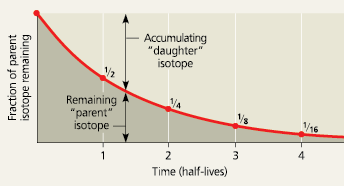
<<Geologic Record:<<
tandard time scale that divides Earth’s history into four eons- Hadean, Archaean, Proterozoic, and Phanerozoic- and subdivided into eras, periods, and epochs
The geologic record
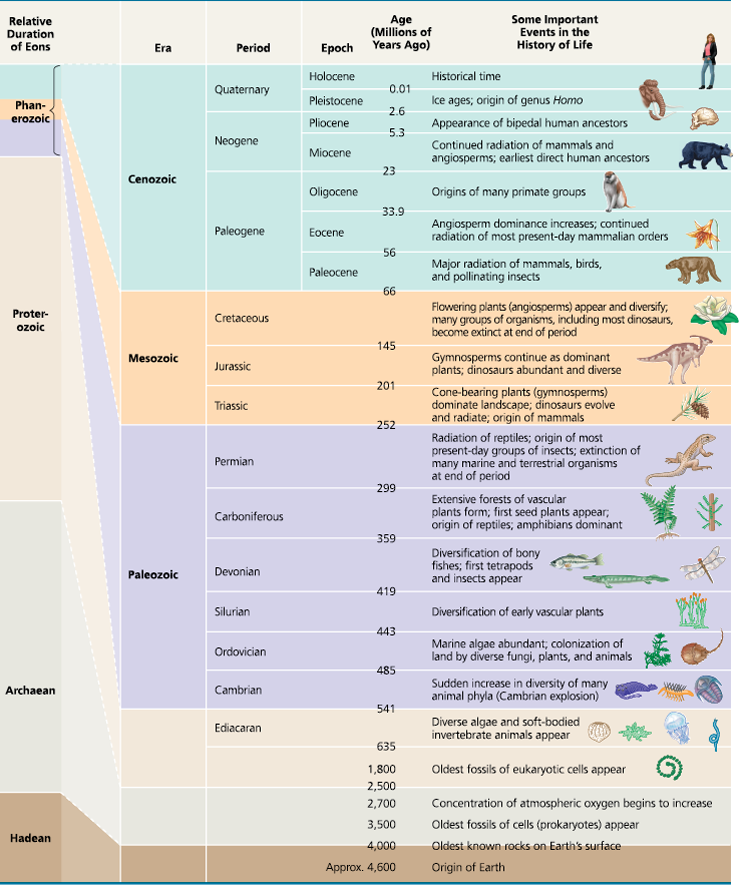
<<Stromatolite:<<
Layered rock that results from the activities of prokaryotes that bind thin films of sediment together
Exploring the Origin of Mammals
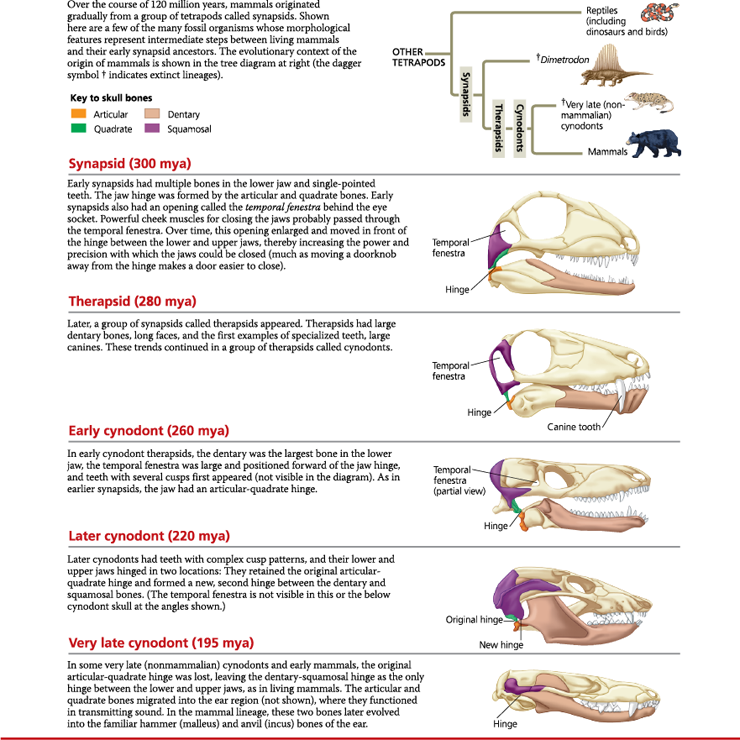
==Your measurements indicate that a fossilized skull you unearthed has a carbon-14/carbon-12 ratio about 1/16 that of the skulls of present-day animals. What is the approximate age of the fossilized skull?==
22,920 years (four half-lives: 5,730 × 4)
==Describe an example from the fossil record that shows how life has changed over time==
The fossil record shows that different groups of organisms dominated life on Earth at different points in time and that many organisms once alive are now extinct; specific examples of these points can be found in Figure 23.3. The fossil record also indicates that new groups of organisms can arise via the gradual modification of previously existing organisms, as illustrated by fossils that document the origin of mammals from their cynodont ancestors
==What might a fossil record of life today look like?==
A fossil record of life today would include many organisms with hard body parts (such as vertebrates and many marine invertebrates), but might not include some species we are very familiar with, such as those that have small geographic ranges and/or small population sizes (for example, endangered species such as the giant panda, tiger, and several rhinoceros species)
==Suppose researchers discover a fossil of an organism that lived 300 million years ago but had mammalian teeth and a mammalian jaw hinge. What inferences might you draw from this fossil about the origin of mammals and the evolution of novel skeletal structures?==
The discovery of such a (hypothetical) fossil organism would indicate that aspects of our current understanding of the origin of mammals are not correct because mammals are thought to have originated much more recently (see Figure 23.5). For example, such a discovery could suggest that the dates of previous fossil discoveries are not correct or that the lineages shown in Figure 23.5 shared features with mammals but were not their direct ancestors. Such a discovery would also suggest that radical changes in multiple aspects of the skeletal structure of organisms could arise suddenly—an idea that is not supported by the known fossil record
==What are the challenges of estimating the absolute ages of old fossils? Explain how these challenges may be overcome in some circumstances==
One challenge is that radioisotopes with very long half-lives are not used by organisms to build their bones or shells. As a result, fossils older than 75,000 years cannot be dated directly. Fossils are often found in sedimentary rock, but those rocks typically contain sediments of different ages, again posing a challenge when trying to date old fossils. To circumvent these challenges, geologists use radioisotopes with long half-lives to date layers of volcanic rock that surround old fossils. This approach provides minimum and maximum estimates for the ages of fossils sandwiched between two layers of volcanic rock
<<23.2 - The rise and fall of groups of organisms reflect differences in speciation and extinction rates<<
In plate tectonics, continental plates move gradually over time, altering the physical geography and climate of Earth. These changes lead to extinctions in some groups of organisms and bursts of speciation in others
Evolutionary history has been punctuated by five mass extinctions that radically altered the history of life. Some of these extinctions may have been caused by changes in continent positions, volcanic activity, or impacts from meteorites or comets
Large increases in the diversity of life have resulted from adaptive radiations that followed mass extinctions. Adaptive radiations have also occurred in groups of organisms that possessed major evolutionary innovations or that colonized new regions in which there was little competition from other organisms
How speciation and extinction affect diversity - The species diversity of an evolutionary lineage will increase when more new member species originate than are lost to extinction. In this hypothetical example, by 2 million years ago both lineage A and lineage B have given rise to four species, and no species have become extinct (denoted by a dagger symbol †). By time 0, however, lineage A contains only one species, while lineage B contains eight species
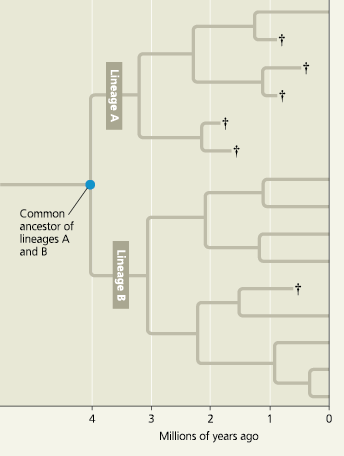
<<Plate Tectonics:<<
The theory that the continents are part of great plates of Earth’s crust that float on the hot, underlying portion of the mantle. Movements in the mantle cause the continents to move slowly over time
Cutaway view of Earth - the thickness of the crust I exaggerated here
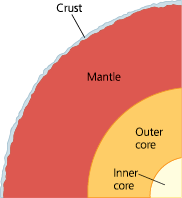
Earth’s major tectonic plates - The arrows indicate direction of movement. The reddish orange dots represent zones of violent tectonic activity
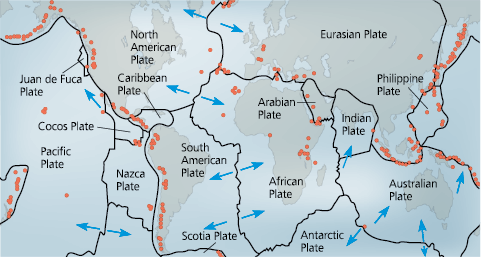
<<Pangaea:<<
The supercontinent that formed near the end of the Paleozoic era, when plate movements brought all the landmasses of Earth together
The history of continental drift during the Phanerozoic eon
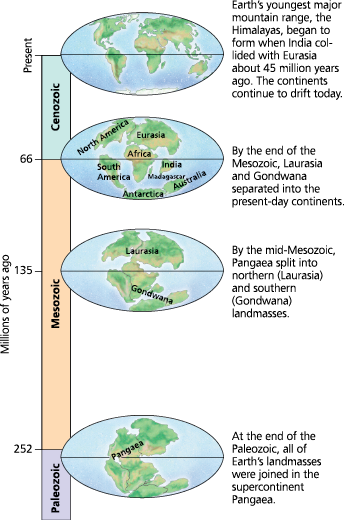
==Is the Australian plate’s current direction of movement (see Figure 23.8) similar to the direction it traveled over the past 66 million years?==
The Australian plate’s current direction of movement is roughly similar to the northeasterly direction the continent traveled over the past 66 million years
Continental drift also ___ allopatric speciation on a grand scale
- promotes
Continental drift can help explain puzzles about the geographic ___ of extinct organisms, such as why fossils of the same species of Permian freshwater reptiles have been discovered in both Brazil and the West African nation of Ghana. These two parts of the world, now separated by 3,000 km of ocean, were joined together when these reptiles were living
- distribution
Speciation in frogs as a result of continental drift - When present-day Madagascar began to separate from India 88 million years ago (1), the frog subfamilies Mantellinae and Rhacophorinae started to diverge, ultimately forming hundreds of new species in each location. The maps show the movement of Madagascar (red) and India (green) over time
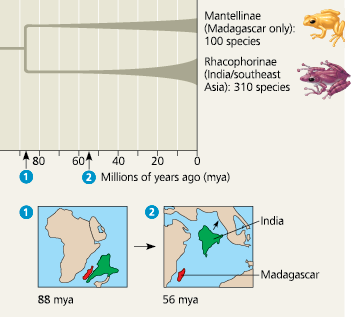
<<Mass Extinction:<<
The elimination of a large number of species throughout Earth, the result of global environmental changes
Mass extinction and the diversity of life - The five generally recognized mass extinction events, indicated by red arrows, represent peaks in the extinction rate of marine animal families (red line and left vertical axis). These mass extinctions interrupted the overall increase over time in the number of extant families of marine animals (blue line and right vertical axis)
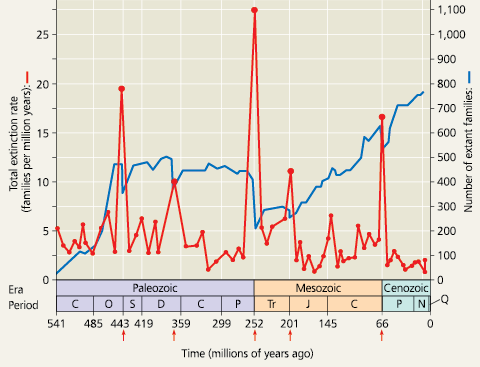
Trauma for Cretaceous life - Beneath the Caribbean Sea, the 66-million-year-old Chicxulub crater measures 180 km across. The horseshoe shape of the crater and the pattern of debris in sedimentary rocks indicate that an asteroid or comet struck at a low angle from the southeast. This drawing represents the impact and its immediate effect: a cloud of hot vapor and debris that could have killed many of the plants and animals in North America within hours
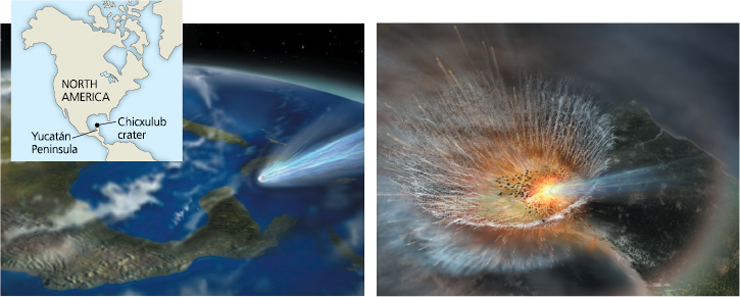
Fossil extinction and temperature - Extinction rates increased when global temperatures were high. Temperatures were estimated using ratios of oxygen isotopes and converted to an index in which 0 is the overall average temperature
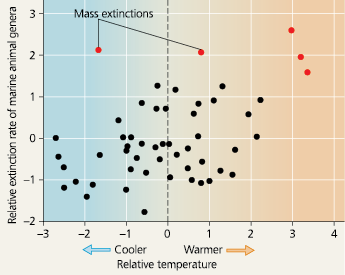
By eliminating large numbers of species, a mass extinction can ___ a thriving and complex ecological community to a pale shadow of its former self
- reduce
Mass extinctions and ecology - The Permian and Cretaceous mass extinctions (indicated by red arrows) altered the ecology of the oceans by increasing the percentage of marine genera that were predators
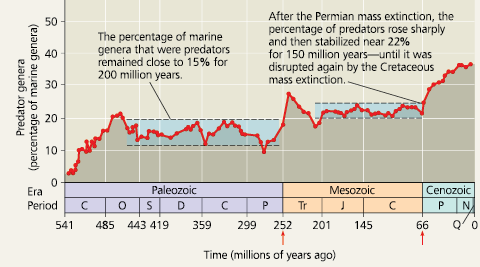
<<Adaptive Radiation:<<
Period of evolutionary change in which groups of organisms form many new species whose adaption allow them to fill different ecological roles in their communities
Adaptive radiation of mammals
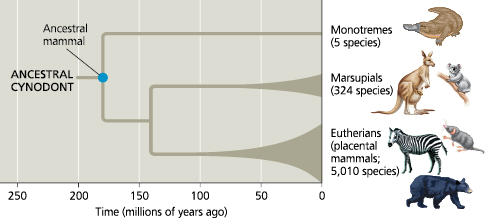
Adaptive radiation on the Hawaiian Islands - Molecular analysis indicates that these remarkably varied Hawaiian plants, known collectively as the “silversword alliance,” are all descended from an ancestral tarweed that arrived on the islands from North America about 5 million years ago. Members of the silversword alliance have since spread into different habitats and formed new species with strikingly different adaptations
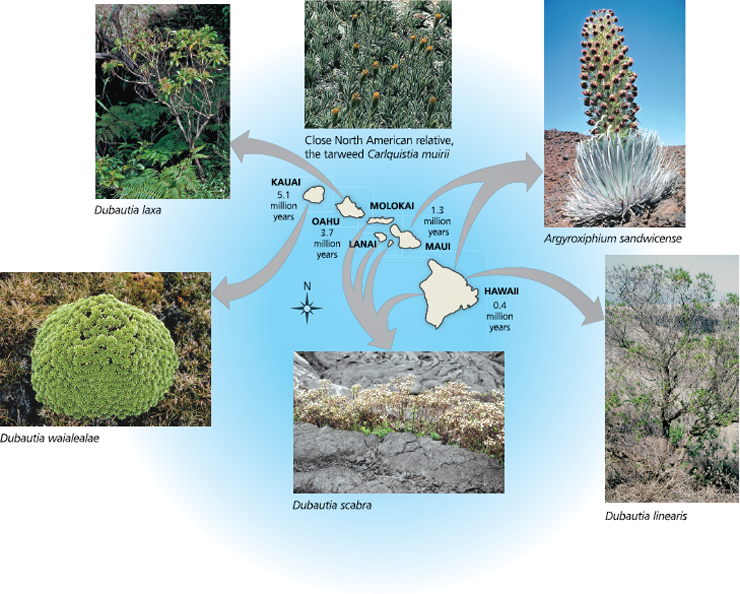
==Explain the consequences of plate tectonics for life on Earth==
The theory of plate tectonics describes the movement of Earth’s continental plates, which alters the physical geography and climate of Earth, as well as the extent to which organisms are geographically isolated. Because these factors affect extinction and speciation rates, plate tectonics has a major impact on life on Earth
==Summarize how mass extinctions affect the evolutionary history of life==
In each of the five mass extinctions documented in the fossil record, 50% or more of marine species became extinct, as did large numbers of terrestrial species. As a result, a mass extinction alters the course of evolution dramatically, removing many evolutionary lineages and reducing the diversity of life on Earth for millions of years. A mass extinction can also change ecological communities by changing the types of organisms that live in them
==What promotes adaptive radiation?==
Mass extinctions; major evolutionary innovations; the diversification of another group of organisms (which can provide new sources of food); migration to new locations where few competitor species exist
==Suppose that an invertebrate species was lost in a mass extinction caused by a sudden catastrophic event. Would the last appearance of this species in the fossil record necessarily be close to when the extinction actually occurred? Would the answer to this question differ depending on whether the species was common (abundant and widespread) or rare?==
In theory, fossils of both common and rare species would be present right up to the time of the catastrophic event, then disappear. Reality is more complicated because the fossil record is not perfect. So the most recent fossil for a species might be a million years before the mass extinction— even though the species did not become extinct until the mass extinction. This complication is especially likely for rare species because few of their fossils will form and be discovered. Hence, for many rare species, the fossil record would not document that the species was alive immediately before the extinction (even if it was)
==Explain how the broad evolutionary changes seen in the fossil record are the cumulative result of speciation and extinction events==
The broad evolutionary changes documented by the fossil record reflect the rise and fall of major groups of organisms. In turn, the rise or fall of any particular group results from a balance between speciation and extinction rates: A group increases in size when the rate at which its members produce new species is greater than the rate at which its member species are lost to extinction, while a group shrinks in size if extinction rates are greater than speciation rates
<<23.3 - Major changes in body form can result from changes in the sequences and regulation of developmental genes<<
Developmental genes affect morphological differences between species by influencing the rate, timing, and spatial patterns of change in an organism’s form as it develops into an adult
The evolution of new forms can be caused by changes in the nucleotide sequences or regulation of developmental genes
<<Heterochrony:<<
Evolutionary change in the timing or rate of an organism’s development
Skull growth - In the human evolutionary lineage, mutations slowed the growth of the jaw relative to other parts of the skull. As a result, in humans the skull of an adult is more similar to the skull of an infant than is the case for chimpanzees
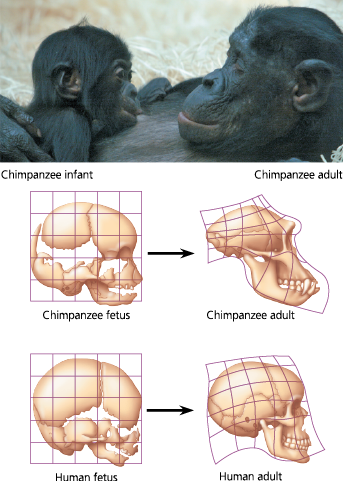
Bat hand and finger bones - Heterochrony is responsible for the increased total length of hand and finger bones in a bat compared to that of other mammals
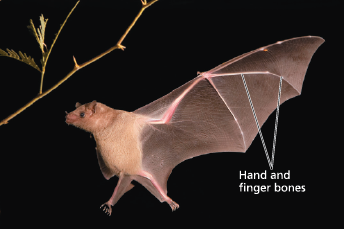
<<Paedomorphosis:<<
The retention in an adult organism of the juvenile features of its evolutionary ancestors
The adults of some species retain features that were juvenile in ancestors. This salamander is an axolotl, an aquatic species that becomes a sexually mature adult while retaining certain larval (tadpole) characteristics, including gills
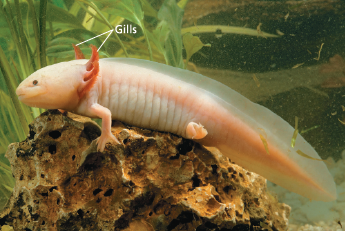
<<Homeotic Gene:<<
Any of the master regulatory genes that control the placement and spatial organization of body parts in animals, plants, and fungi by controlling the developmental fate of groups of cells
Effects of the Hox gene Ubx on the insect body plan - In crustaceans, the Hox gene Ubx is expressed in the region shaded green, the body segments between the head and genital segments. In insects, Ubx is expressed in only a subset (shaded pink) of the homologous body segments, where it suppresses leg formation
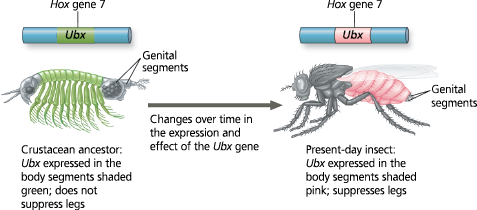
==Explain how new body forms can originate by heterochrony==
Heterochrony can cause a variety of morphological changes. For example, if the onset of sexual maturity changes, a retention of juvenile characteristics (paedomorphosis) may result. Paedomorphosis can be caused by small genetic changes that result in large changes in morphology, as seen in the axolotl salamander
==Why is it likely that Hox genes have played a major role in the evolution of novel morphological forms?==
In animal embryos, Hox genes influence the development of structures such as limbs and feeding appendages. As a result, changes in these genes—or in the regulation of these genes—are likely to have major effects on morphology
==Given that changes in morphology are often caused by changes in the regulation of gene expression, predict whether noncoding DNA is likely to be affected by natural selection==
From genetics, we know that gene regulation is altered by how well transcription factors bind to noncoding DNA sequences called control elements. Thus, if changes in morphology are often caused by changes in gene regulation, portions of noncoding DNA that contain control elements are likely to be strongly affected by natural selection
==How could changes in a single gene or DNA region ultimately lead to the origin of a new group of organisms?==
A change in the sequence or regulation of a developmental gene can produce major morphological changes. In some cases, such morphological changes may enable organisms to perform new functions or live in new environments—thus potentially leading to an adaptive radiation and the formation of a new group of organisms
<<23.4 - Evolution is not goal oriented<<
Novel and complex biological structures can evolve through a series of incremental modifications, each of which benefits the organism that possesses it
Evolutionary trends can be caused by factors such as natural selection in a changing environment or species selection. Like all aspects of evolution, evolutionary trends result from interactions between organisms and their current environments
What three things has ‘evolution tinkering’ led to?
The striking ways in which organisms are suited for life in their environments, the many shared characteristics of life, and the rich diversity of life
Darwin’s concept of descent with modification says as new species form, novel and complex structures can arise as ___ modifications of ancestral structures
- gradual
Jacob’s concept of evolutionary tinkering says it’s a process in which new forms arise by the modification of existing ___
- structures or existing developmental genes
A range of eye complexity among molluscs
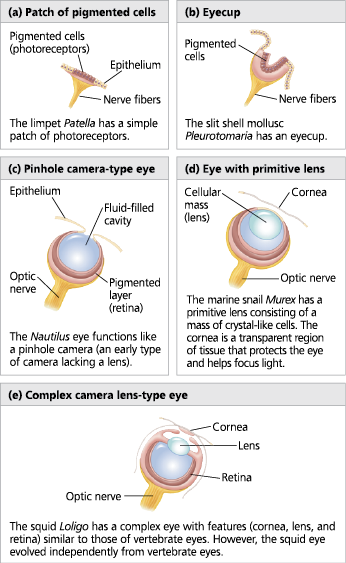
Natural selection cannot predict the future; it can only improve a structure in the context of its ___ utility
- current
Horse evolution - Using yellow to trace a sequence of fossil horses that are intermediate in form between the present-day horse (Equus) and its Eocene ancestor Hyracotherium creates the illusion of a progressive trend toward larger size, reduced number of toes, and teeth modified for grazing. In fact, Equus is the only surviving twig of an evolutionary bush with many divergent trends
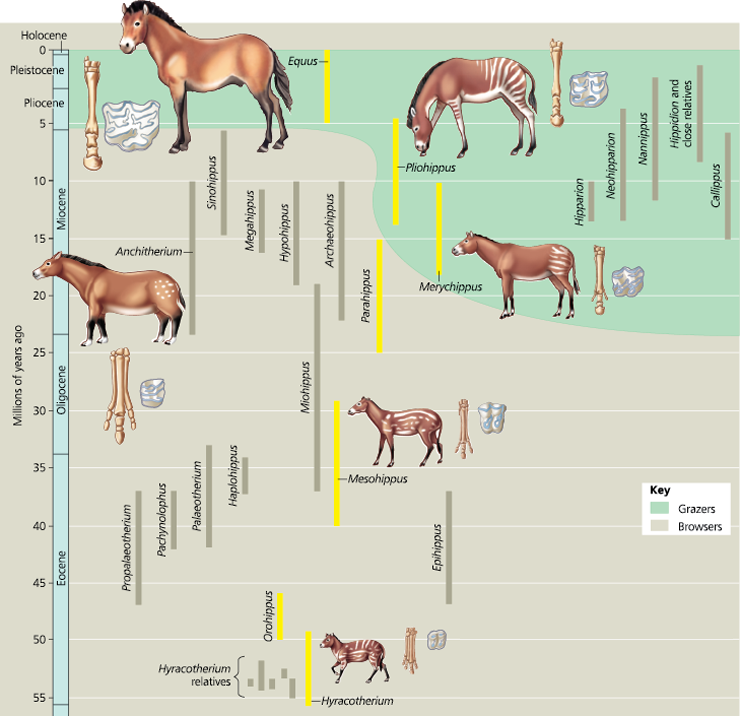
==How can the Darwinian concept of descent with modification explain the evolution of such complex structures as the vertebrate eye?==
Complex structures do not evolve all at once, but in increments, with natural selection selecting for adaptive variants of the earlier versions
==The myxoma virus kills up to 99.8% of infected European rabbits in populations with no previous exposure to the virus. The virus is transmitted between living rabbits by mosquitoes. Describe an evolutionary trend (in either the rabbit or virus) that might occur after a rabbit population first encounters the virus==
Although the myxoma virus is highly lethal, initially some of the rabbits are resistant (0.2% of infected rabbits are not killed). Thus, assuming resistance is an inherited trait, we would expect the rabbit population to show a trend for increased resistance to the virus. We would also expect the virus to show an evolutionary trend toward reduced lethality. We would expect this trend because a rabbit infected with a less lethal virus would be more likely to live long enough for a mosquito to bite it and hence potentially transmit the virus to another rabbit. (A virus that kills its rabbit host before a mosquito transmits the virus to another rabbit dies with its host.)
==Explain the reasoning behind the statement “Evolution is not goal oriented”==
Evolutionary change results from interactions between organisms and their current environments. No goal is involved in this process. As environments change over time, the features of organisms favored by natural selection may also change. When this happens, what once may have seemed like a “goal” of evolution (for example, improvements in the function of a feature previously favored by natural selection) may cease to be beneficial or may even be harmful